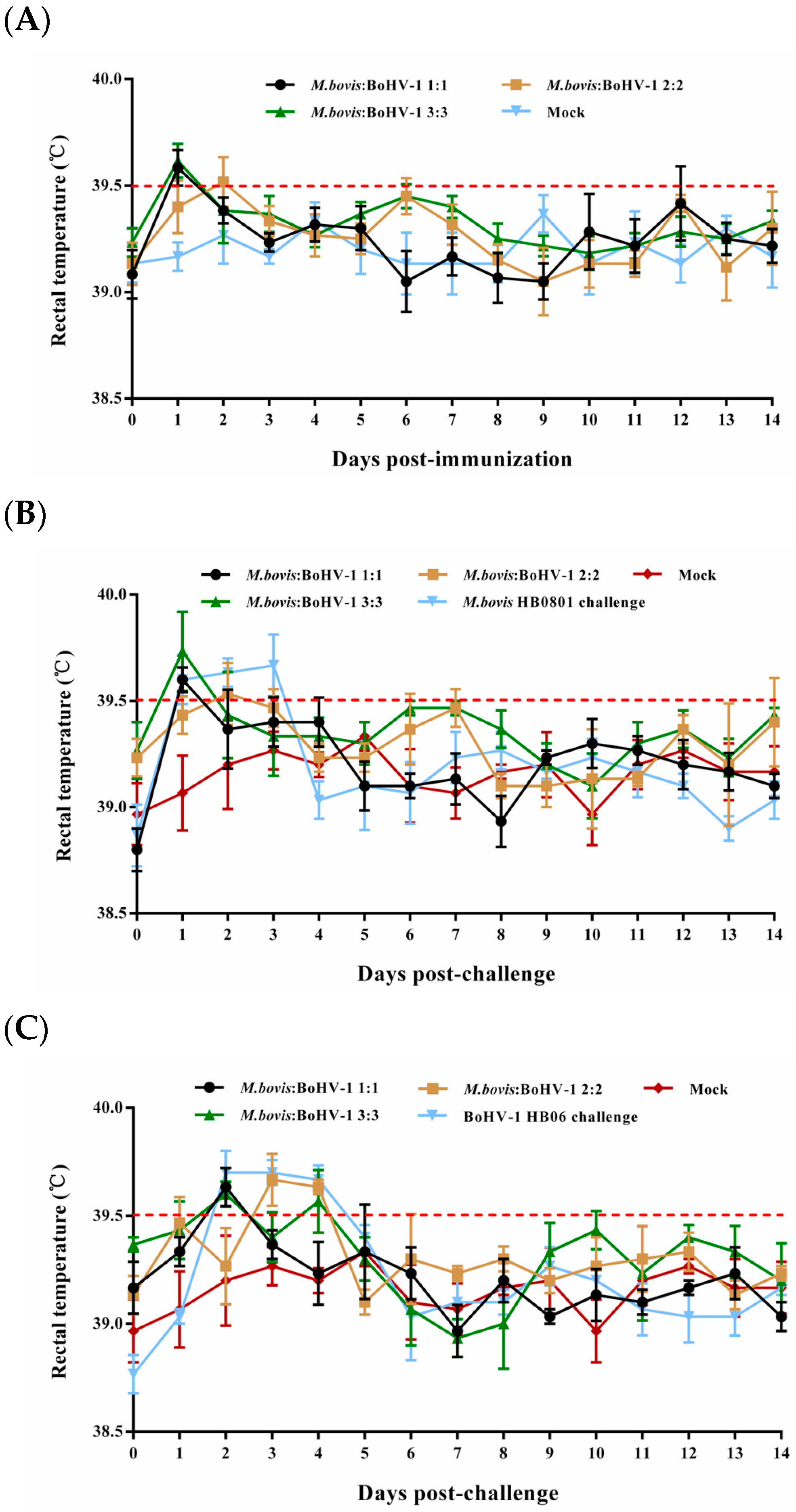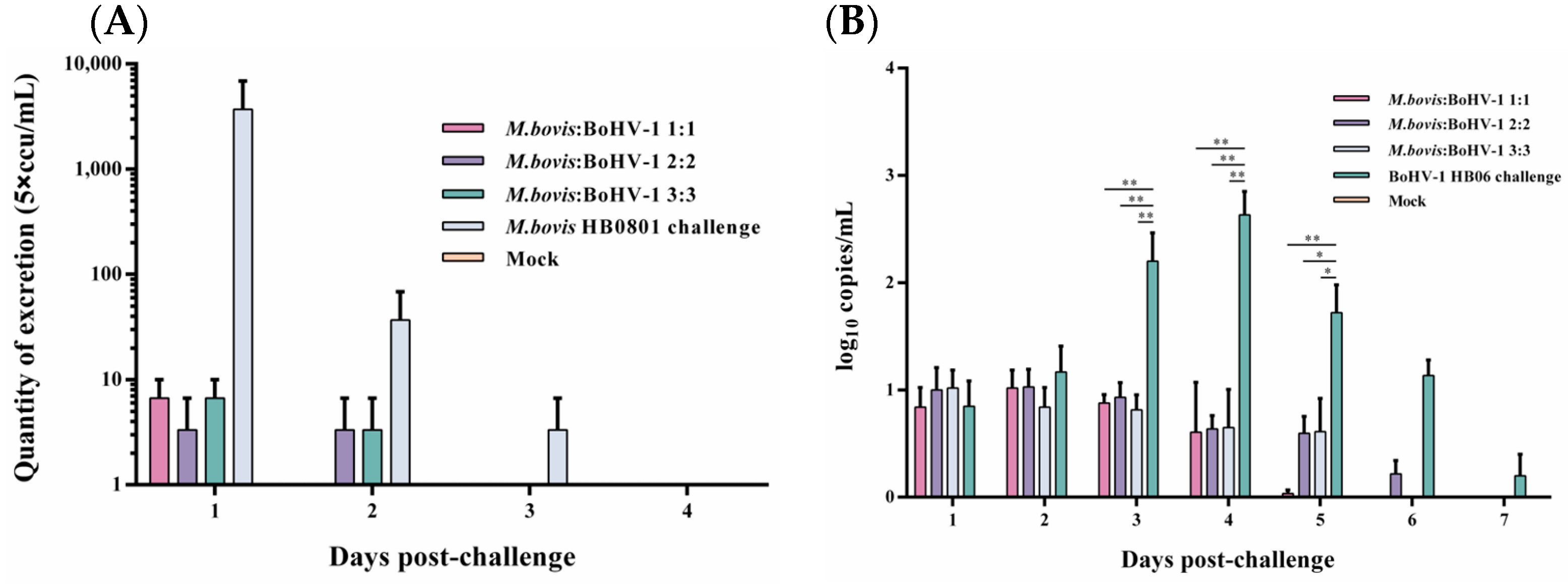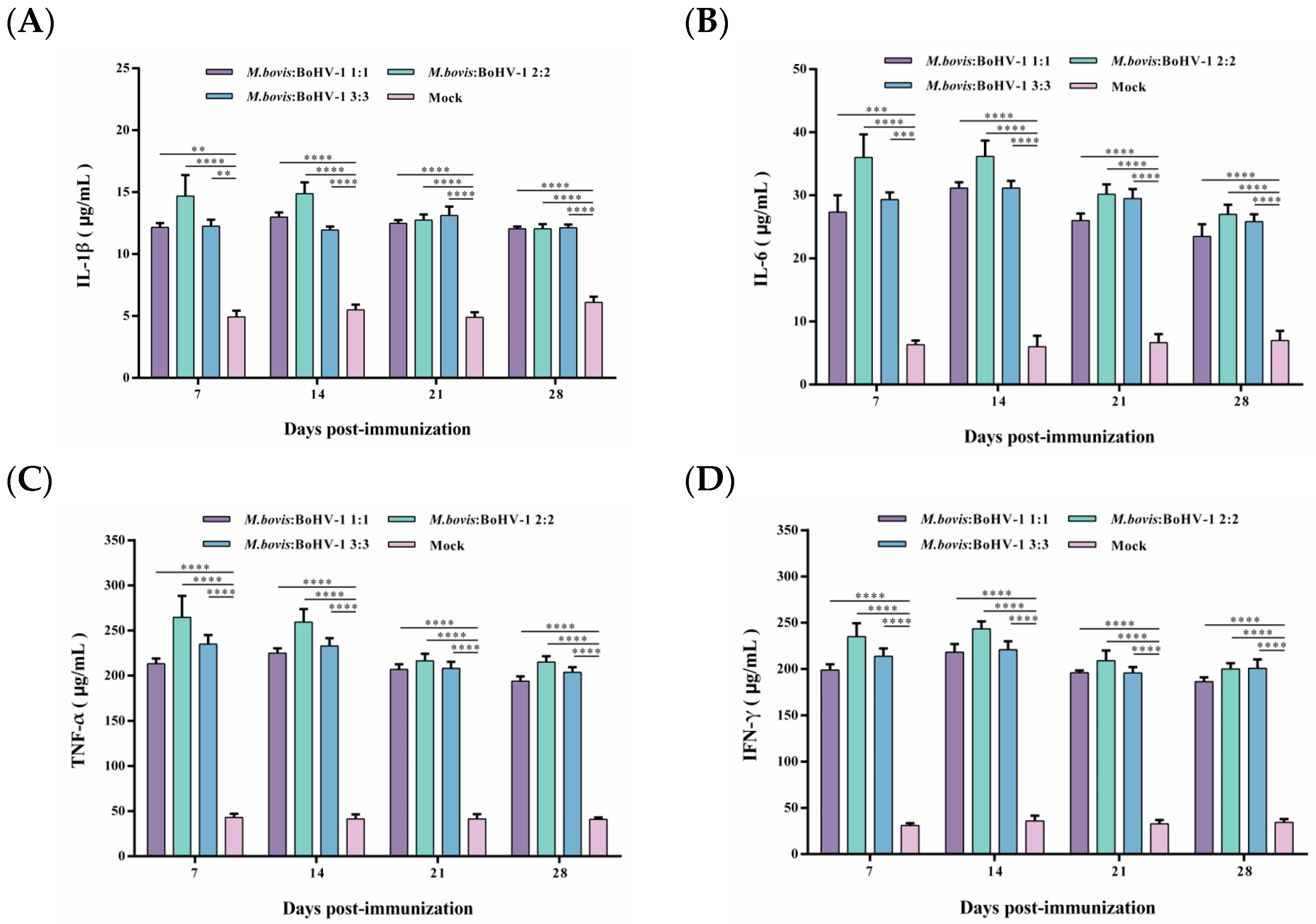Investigation of the Optimal Immunization Dose and Protective Efficacy of an Attenuated and Marker M. bovis–Bovine Herpesvirus Type 1 Combined Vaccine in Rabbits
Abstract
:Simple Summary
Abstract
1. Introduction
2. Materials and Methods
2.1. Cells and Viruses
2.2. Culture of M. bovis and BoHV-1
2.3. Animal Experiments
2.4. Clinical Evaluation and Sample Collection
2.5. Virus and Bacteria Shedding
2.6. Serum Antibody of M. bovis
2.7. Neutralization Assay
2.8. Detection of Cytokines and ELISA Antibodies
2.9. Calculation of Protective Efficacy
2.10. Statistical Analysis
3. Results
3.1. Clinical Signs
3.2. Detection of M. bovis and BoHV-1 Shedding
3.2.1. M. bovis HB150 and BoHV-1 gG-/tk- Shedding after Immunization
3.2.2. M. bovis HB0801 and BoHV-1 HB06 Shedding after Challenge
3.3. Antibody Response
3.3.1. M. bovis Serum Antibody Levels
3.3.2. BoHV-1-Neutralizing Antibody Response
3.4. M. bovis–BoHV-1 Combined Vaccine Induces Cellular Immunity in Rabbits
3.5. sIgA and IgG Titers in Rabbits
3.6. Evaluation of Micro Pathological Injury
3.7. Calculation of Protective Rate of the Attenuated and Marker M. bovis–BoHV-1 Combined Vaccine after Challenge
4. Discussion
5. Conclusions
Author Contributions
Funding
Institutional Review Board Statement
Informed Consent Statement
Data Availability Statement
Conflicts of Interest
References
- Nicola, I.; Cerutti, F.; Grego, E.; Bertone, I.; Gianella, P.; D’Angelo, A.; Peletto, S.; Bellino, C. Characterization of the upper and lower respiratory tract microbiota in Piedmontese calves. Microbiome 2017, 5, 152. [Google Scholar] [CrossRef]
- Loneragan, G.H.; Dargatz, D.A.; Morley, P.S.; Smith, M.A. Trends in mortality ratios among cattle in US feedlots. J. Am. Vet. Med. Assoc. 2001, 219, 1122–1127. [Google Scholar] [CrossRef] [PubMed]
- Edwards, T.A. Control Methods for Bovine Respiratory Disease for Feedlot Cattle. Vet. Clin. N. Am. Food Anim. Pract. 2010, 26, 273–284. [Google Scholar] [CrossRef] [PubMed]
- Dudek, K.; Szacawa, E. Infections: Occurrence, Pathogenesis, Diagnosis and Control, Including Prevention and Therapy. Pathogens 2020, 9, 994. [Google Scholar] [CrossRef] [PubMed]
- Gandhi, N.N.; Inzana, T.J.; Rajagopalan, P. Bovine Airway Models: Approaches for Investigating Bovine Respiratory Disease. ACS Infect. Dis. 2023, 9, 1168–1179. [Google Scholar] [CrossRef] [PubMed]
- Dubrovsky, S.A.; Van Eenennaam, A.L.; Aly, S.S.; Karle, B.M.; Rossitto, P.V.; Overton, M.W.; Lehenbauer, T.W.; Fadel, J.G. Preweaning cost of bovine respiratory disease (BRD) and cost-benefit of implementation of preventative measures in calves on California dairies: The BRD 10K study. J. Dairy Sci. 2020, 103, 1583–1597. [Google Scholar] [CrossRef] [PubMed]
- Blakebrough-Hall, C.; McMeniman, J.P.; González, L.A. An evaluation of the economic effects of bovine respiratory disease on animal performance, carcass traits, and economic outcomes in feedlot cattle defined using four BRD diagnosis methods. J. Anim. Sci. 2020, 98, skaa005. [Google Scholar] [CrossRef]
- Ellis, J.A. The immunology of the bovine respiratory disease complex. Vet. Clin. N. Am.-Food Anim. Pract. 2001, 17, 535–550. [Google Scholar] [CrossRef] [PubMed]
- Guo, T.; Zhang, J.H.; Chen, X.D.; Wei, X.; Wu, C.X.; Cui, Q.; Hao, Y.Q. Investigation of viral pathogens in cattle with bovine respiratory disease complex in Inner Mongolia, China. Microb. Pathog. 2021, 153, 104594. [Google Scholar] [CrossRef]
- McGill, J.L.; Sacco, R.E. The Immunology of Bovine Respiratory Disease Recent Advancements. Vet. Clin. N. Am.-Food Anim. Pract. 2020, 36, 333–348. [Google Scholar] [CrossRef]
- Klima, C.L.; Zaheer, R.; Cook, S.R.; Booker, C.W.; Hendrick, S.; Alexander, T.W.; McAllister, T.A. Pathogens of Bovine Respiratory Disease in North American Feedlots Conferring Multidrug Resistance via Integrative Conjugative Elements. J. Clin. Microbiol. 2014, 52, 438–448. [Google Scholar] [CrossRef] [PubMed]
- Zhang, S.; Zhang, Y.S.; Liu, G.X.; Wang, C.; Ji, Y.; Chen, J.G.; Hu, C.M.; Chen, X.; Guo, A.Z.; Chen, Y.Y.; et al. The Safety and Protective Efficacy Evaluation of an Attenuated-BoHV-1 Bivalent Vaccine in Rabbits. Vaccines 2023, 11, 1698. [Google Scholar] [CrossRef] [PubMed]
- Qi, J.J.; Guo, A.Z.; Cui, P.; Chen, Y.Y.; Mustafa, R.; Ba, X.L.; Hu, C.M.; Bai, Z.D.; Chen, X.; Shi, L.; et al. Comparative Geno-Plasticity Analysis of Mycoplasma bovis HB0801 (Chinese Isolate). PLoS ONE 2012, 7, e38239. [Google Scholar] [CrossRef] [PubMed]
- Chen, X.L.; Wang, X.; Qi, Y.P.; Wen, X.B.; Li, C.X.; Liu, X.B.; Ni, H.B. Meta-analysis of prevalence of bovine herpes virus 1 in cattle in Mainland China. Acta Trop. 2018, 187, 37–43. [Google Scholar] [CrossRef] [PubMed]
- Zhang, R.; Han, X.X.; Chen, Y.Y.; Mustafa, R.; Qi, J.J.; Chen, X.; Hu, C.M.; Chen, H.C.; Guo, A.Z. Attenuated Mycoplasma bovis strains provide protection against virulent infection in calves. Vaccine 2014, 32, 3107–3114. [Google Scholar] [CrossRef] [PubMed]
- Zhang, M.M.; Fu, S.L.; Deng, M.L.; Xie, Q.; Xu, H.Y.; Liu, Z.F.; Hu, C.M.; Chen, H.C.; Guo, A.Z. Attenuation of bovine herpesvirus type 1 by deletion of its glycoprotein G and tk genes and protection against virulent viral challenge. Vaccine 2011, 29, 8943–8950. [Google Scholar] [CrossRef] [PubMed]
- Booker, C.W.; Abutarbush, S.M.; Morley, P.S.; Jim, G.K.; Pittman, T.J.; Schunicht, O.C.; Perrett, T.; Wildman, B.K.; Fenton, R.K.; Guichon, P.T.; et al. Microbiological and histopathological findings in cases of fatal bovine respiratory disease of feedlot cattle in western Canada. Can. Vet. J.-Rev. Vet. Can. 2008, 49, 473–481. [Google Scholar]
- Ellis, J.A.; Gow, S.P.; Goji, N.; Jones, C.; Workman, A.; Henderson, G.; Rhodes, C.; Alaniz, G.; Meinert, T.R.; Tucker, C.M. Efficacy of a combination viral vaccine for protection of cattle against experimental infection with field isolates of bovine herpesvirus-1. JAVMA-J. Am. Vet. Med. Assoc. 2009, 235, 563–572. [Google Scholar] [CrossRef] [PubMed]
- Brock, K.V.; Widel, P.; Watz, P.; Walz, H.L. Onset of protection from experimental infection with type 2 bovine miral diarrhea virus following vaccination with a modified-live vaccine. Vet. Ther. 2007, 8, 88–96. [Google Scholar] [PubMed]
- Palomares, R.A.; Givens, D.; Wright, J.C.; Walz, P.H.; Brock, K.V. Evaluation of the onset of protection induced by a modified-live virus vaccine in calves challenge inoculated with type 1b bovine viral diarrhea virus. Am. J. Vet. Res. 2012, 73, 567–574. [Google Scholar] [CrossRef]
- Ellis, J.; Gow, S.; Bolton, M.; Burdett, W.; Nordstrom, S. Inhibition of priming for bovine respiratory syncytial virus-specific protective immune responses following parenteral vaccination of passively immune calves. Can. Vet. J.-Rev. Vet. Can. 2014, 55, 1180–1185. [Google Scholar]
- Mahan, S.M.; Sobecki, B.; Johnson, J.; Oien, N.L.; Meinert, T.R.; Verhelle, S.; Mattern, S.J.; Bowersock, T.L.; Leyh, R.D. Efficacy of intranasal vaccination with a multivalent vaccine containing temperature-sensitive modified-live bovine herpesvirus type 1 for protection of seronegative and seropositive calves against respiratory disease. JAVMA-J. Am. Vet. Med. Assoc. 2016, 248, 1280–1286. [Google Scholar] [CrossRef] [PubMed]
- Chung, Y.C.; Shen, H.Y.; Cheng, L.T.; Liu, S.S.; Chu, C.Y. Effectiveness of a BHV-1/BEFV bivalent vaccine against bovine herpesvirus type 1 infection in cattle. Res. Vet. Sci. 2016, 109, 161–165. [Google Scholar] [CrossRef] [PubMed]
- Salt, J.S.; Thevasagayam, S.J.; Wiseman, A.; Peters, A.R. Efficacy of a quadrivalent vaccine against respiratory diseases caused by BHV-1, PI3V, BVDV and BRSV in experimentally infected calves. Vet. J. 2007, 174, 616–626. [Google Scholar] [CrossRef] [PubMed]
- Belknap, E.B.; Walters, L.M.; Kelling, C.; Ayers, V.K.; Norris, J.; McMillen, J.; Hayhow, C.; Cochran, M.; Reddy, D.N.; Wright, J.; et al. Immunogenicity and protective efficacy of a gE, gG and US2 gene-deleted bovine herpesvirus-1 (BHV-1) vaccine. Vaccine 1999, 17, 2297–2305. [Google Scholar] [CrossRef] [PubMed]
- Gondaira, S.; Higuchi, H.; Iwano, H.; Nakajima, K.; Kawai, K.; Hashiguchi, S.; Konnai, S.; Nagahata, H. Cytokine mRNA profiling and the proliferative response of bovine peripheral blood mononuclear cells to Mycoplasma bovis. Vet. Immunol. Immunopathol. 2015, 165, 45–53. [Google Scholar] [CrossRef] [PubMed]
- Bringardner, B.D.; Baran, C.P.; Eubank, T.D.; Marsh, C.B. The role of inflammation in the pathogenesis of idiopathic pulmonary fibrosis. Antioxid. Redox Signal. 2008, 10, 287–301. [Google Scholar] [CrossRef] [PubMed]
- Schroder, K.; Hertzog, P.J.; Ravasi, T.; Hume, D.A. Interferon-γ: An overview of signals, mechanisms and functions. J. Leukoc. Biol. 2004, 75, 163–189. [Google Scholar] [CrossRef]
- Risalde, M.A.; Molina, V.; Sánchez-Cordón, P.J.; Pedrera, M.; Panadero, R.; Romero-Palomo, F.; Gómez-Villamandos, J.C. Response of proinflammatory and anti-inflammatory cytokines in calves with subclinical bovine viral diarrhea challenged with bovine herpesvirus-1. Vet. Immunol. Immunopathol. 2011, 144, 135–143. [Google Scholar] [CrossRef] [PubMed]
- Zheng, H.; Ban, Y.; Wei, F.; Ma, X.J. Regulation of Interleukin-12 Production in Antigen-Presenting Cells. Adv. Exp. Med. Biol. 2016, 941, 117–138. [Google Scholar] [PubMed]







| Group | Strain and Dose of Vaccination * | Challenge Strain and Dose ** | Number of Rabbits |
|---|---|---|---|
| 1 | 1.0 × 108 CFU M. bovis HB150 1.0 × 106 TCID50 BoHV-1 gG-/tk- | 1.0 × 109 CFU M. bovis HB0801 | 3 |
| 2 | 1.0 × 108 CFU M. bovis HB150 1.0 × 106 TCID50 BoHV-1 gG-/tk- | 4.0 × 107 TCID50 BoHV-1 HB06 | 3 |
| 3 | 2.0 × 108 CFU M. bovis HB150 2.0 × 106 TCID50 BoHV-1 gG-/tk- | 1.0 × 109 CFU M. bovis HB0801 | 3 |
| 4 | 2.0 × 108 CFU M. bovis HB150 2.0 × 106 TCID50 BoHV-1 gG-/tk- | 4.0 × 107 TCID50 BoHV-1 HB06 | 3 |
| 5 | 3.0 × 108 CFU M. bovis HB150 3.0 × 106 TCID50 BoHV-1 gG-/tk- | 1.0 × 109 CFU M. bovis HB0801 | 3 |
| 6 | 3.0 × 108 CFU M. bovis HB150 3.0 × 106 TCID50 BoHV-1 gG-/tk- | 4.0 × 107 TCID50 BoHV-1 HB06 | 3 |
| 7 | PPLO complete medium | 1.0 × 109 CFU M. bovis HB0801 | 3 |
| 8 | DMEM medium | 4.0 × 107 TCID50 BoHV-1 HB06 | 3 |
| 9 | Blank Control | 3 | |
| Target Gene | Primer Sequence (5′→3′) | Target Gene Length |
|---|---|---|
| gG | Forward: CCGACCGCCTCCTACACCAGATGCT | Delated strain: 524 bp Wildtype strain: 1859 bp |
| Reverse: GGGTGTAGGCAAGCTCACCGCAACG | ||
| TK | Forward: ACGGGCTGGGAAAGACAACAACGG | Delated strain: 235 bp Wildtype strain: 868 bp |
| Reverse: GCGGACACGTCCAGCACGAACA | ||
| gB | Forward: AGCACCTTTGTGGACCTAA | 118 bp |
| Reverse: GCTGTATCTCGCTGTAGTCG | ||
| uvrC | Forward: TAATTTAGAAGCTTTAAATGAGCGC | 238 bp |
| Reverse: CATATCTAGGTCAATTAAGGCTTTG |
| Group | Days Post-Immunization (%) | |||||||||
|---|---|---|---|---|---|---|---|---|---|---|
| 1 | 2 | 3 | 4 | 5 | 6 | 7 | 8 | 9 | ||
| 1&2 (1:1) | M. bovis | 6/6 (100) | 4/6 (66.7) | 4/6 (66.7) | 1/6 (16.7) | 0/6 (0) | 0/6 (0) | 0/6 (0) | 0/6 (0) | 0/6 (0) |
| BoHV-1 | 6/6 (100) | 6/6 (100) | 5/6 (83.3) | 6/6 (100) | 6/6 (100) | 3/6 (50) | 2/6 (33.3) | 1/6 (16.7) | 0/6 (0) | |
| 3&4 (2:2) | M. bovis | 6/6 (100) | 6/6 (100) | 4/6 (66.7) | 4/6 (66.7) | 2/6 (33.3) | 0/6 (0) | 0/6 (0) | 0/6 (0) | 0/6 (0) |
| BoHV-1 | 6/6 (100) | 6/6 (100) | 6/6 (100) | 5/6 (83.3) | 4/6 (66.7) | 2/6 (33.3) | 2/6 (33.3) | 0/6 (0) | 0/6 (0) | |
| 5&6 (3:3) | M. bovis | 6/6 (100) | 5/6 (83.3) | 6/6 (100) | 4/6 (66.7) | 3/6 (50) | 2/6 (33.3) | 0/6 (0) | 0/6 (0) | 0/6 (0) |
| BoHV-1 | 6/6 (100) | 5/6 (83.3) | 6/6 (100) | 6/6 (100) | 4/6 (66.7) | 3/6 (50) | 1/6 (16.7) | 2/6 (33.3) | 0/6 (0) | |
| 9 (mock) | 0/3 | 0/3 | 0/3 | 0/3 | 0/3 | 0/3 | 0/3 | 0/3 | 0/3 | |
| Group | Average Score | Protective Rate (%) | |
|---|---|---|---|
| Clinical Score | Lung Lesion Score | ||
| M. bovis–BoHV-1 1:1 | 0.16 | 5.09 | 71.8% |
| M. bovis–BoHV-1 2:2 | 0.12 | 4.67 | 75.7% |
| M. bovis–BoHV-1 3:3 | 0.14 | 5.33 | 69.9% |
| M. bovis HB0801 challenge | 0.84 | 12.67 | \ |
| Mock | 0 | 2.00 | \ |
| Group | Average Score | Protective Rate (%) | |
|---|---|---|---|
| Clinical Score | Lung Lesion Score | ||
| M. bovis–BoHV-1 1:1 | 0.27 | 3.75 | 83.9% |
| M. bovis–BoHV-1 2:2 | 0.22 | 3.33 | 87.6% |
| M. bovis–BoHV-1 3:3 | 0.31 | 4.33 | 79% |
| BoHV-1 HB06 challenge | 1.3 | 13.25 | \ |
| Mock | 0 | 2.00 | \ |
Disclaimer/Publisher’s Note: The statements, opinions and data contained in all publications are solely those of the individual author(s) and contributor(s) and not of MDPI and/or the editor(s). MDPI and/or the editor(s) disclaim responsibility for any injury to people or property resulting from any ideas, methods, instructions or products referred to in the content. |
© 2024 by the authors. Licensee MDPI, Basel, Switzerland. This article is an open access article distributed under the terms and conditions of the Creative Commons Attribution (CC BY) license (https://creativecommons.org/licenses/by/4.0/).
Share and Cite
Zhang, S.; Liu, G.; Wu, W.; Yang, L.; Shirani, I.; Guo, A.; Chen, Y. Investigation of the Optimal Immunization Dose and Protective Efficacy of an Attenuated and Marker M. bovis–Bovine Herpesvirus Type 1 Combined Vaccine in Rabbits. Animals 2024, 14, 748. https://doi.org/10.3390/ani14050748
Zhang S, Liu G, Wu W, Yang L, Shirani I, Guo A, Chen Y. Investigation of the Optimal Immunization Dose and Protective Efficacy of an Attenuated and Marker M. bovis–Bovine Herpesvirus Type 1 Combined Vaccine in Rabbits. Animals. 2024; 14(5):748. https://doi.org/10.3390/ani14050748
Chicago/Turabian StyleZhang, Sen, Guoxing Liu, Wenying Wu, Li Yang, Ihsanullah Shirani, Aizhen Guo, and Yingyu Chen. 2024. "Investigation of the Optimal Immunization Dose and Protective Efficacy of an Attenuated and Marker M. bovis–Bovine Herpesvirus Type 1 Combined Vaccine in Rabbits" Animals 14, no. 5: 748. https://doi.org/10.3390/ani14050748





